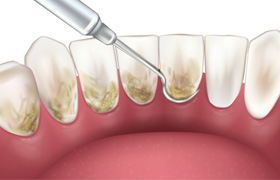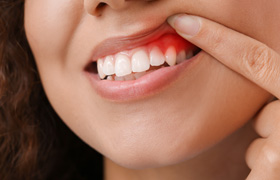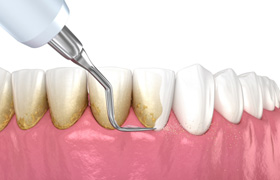Gum Disease Treatment – Deland, FL
Protect Your Oral and Overall Health

Did you know that periodontal disease is one of the most common dental problems in the entire world? It’s true! The Centers for Disease Control estimate that nearly 50% of all U.S. adults currently have some form of the infection right now. Of course, just because something is common doesn’t mean it isn’t dangerous. Left untreated, periodontal disease can lead to devastating consequences. On this page, we discuss what gum disease is, why periodontal therapy in DeLand, FL, is so important, and how our team can help you protect your oral and overall health.
Why Choose Christopher J. Cowell for Gum Disease Treatment?
- Dentist with Decades of Experience
- Friendly & Empathetic Team
- Conservative, Effective Treatment
What Is Gum Disease?

Periodontal disease, which is also commonly known as gum disease, is an infection that causes inflammation of the gum tissue. When plaque and bacteria sneak into the tiny spaces between the gums and the teeth, it irritates the gum tissue and leads to a range of symptoms.
In most cases, missteps in oral hygiene are the main culprit behind periodontal disease. However, many other factors can contribute to this condition. Genetics, smoking, a poor diet, and diabetes can all play a role in causing or worsening periodontal disease.
Symptoms of Gum Disease

There are two stages of gum disease:
Gingivitis: This is the earliest form of gum disease. Symptoms are usually mild and include red, tender, and swollen gums. At this point, no permanent damage to the gums or bones has occurred.
Periodontitis: Left untreated, gingivitis can progress to periodontitis. Symptoms include persistent bad breath, gum recession, and loose teeth. In some cases, periodontitis can cause the teeth to fall out altogether.
Untreated gum disease can do much more than just damage your smile. It has also been shown to drastically increase a person’s chances of developing a number of systemic health problems, such as heart disease and dementia. Such issues may occur when the bacteria that cause gum disease sneak into the bloodstream and travel to other bodily systems.
How Do We Treat Gum Disease?

Dr. Cowell and our team will screen your gums every time you come to see us. We will check for recession and any other signs of infection. If we spot a problem, we might be able to help you regain your gum health via a few adjustments to your oral hygiene routine. It is also possible that we will recommend that you undergo scaling and root planing.
Scaling & Root Planing

A regular dental cleaning often isn’t enough to address gum disease. In many cases, you will require a deep cleaning, which consists of two major steps: scaling and root planing. Thanks to this form of gum disease treatment, our team can address your gum infection at the source and prevent it from growing worse. Not only can we get rid of the bacteria that are currently in your mouth, but we can reduce the chances of plaque and tartar gathering beneath the gums in the future.
Do You Need Scaling & Root Planing?

This is a question that our team can answer for you after performing a careful examination of your mouth. The current severity of your gum disease will help us determine whether scaling and root planing are truly necessary.
Below are some examples of symptoms that may indicate a possible need for a deep cleaning:
- Your gums have a tendency to bleed whenever you brush or floss your teeth.
- You have noticed that your teeth look longer due to receding gums.
- You constantly have bad breath no matter what you do.
- Your teeth have started to shift.
- You have difficulty chewing your food.
Call us immediately if you notice any of these symptoms; gum disease is not a condition that you can afford to ignore for too long.
The Process of Scaling & Root Planing

We’ll begin with scaling. Similar to a traditional dental cleaning, this involves gently removing the plaque and tartar that’s contributing to gum disease. We’ll pay particularly close attention to the area around and below your gum line, and we’ll clean all the way down to the bottom of any periodontal pockets that have formed.
Once we’re done with scaling, we can move on to root planing, which is where we smooth out the roots of the teeth. This step has two major benefits. The first is that it makes it harder for bacteria to build up on the roots in the future. The second is that it encourages the gums to reattach themselves to the teeth.
Aftercare Tips for Scaling & Root Planing

After scaling and root planing, your mouth will still be numb due to the use of a local anesthetic. Until the effects of the anesthetic wear off, you should avoid eating anything; otherwise, you might risk biting your tongue or cheek by mistake.
While your mouth is recovering from scaling and root planing, remember to rinse with salt water every few hours. This will help reduce inflammation and soothe any discomfort you may be experiencing. You can also take an over-the-counter pain reliever if you need to.
As far as oral hygiene is concerned, you will still be able to brush your teeth as you normally would. However, you will need to be gentle when you’re cleaning near the areas where scaling and root planing were performed.

